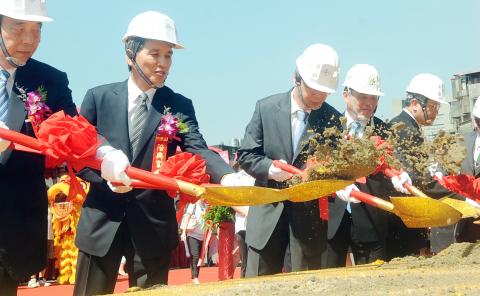The government broke ground for a new exhibition hall in Nangang District (南港), Taipei, yesterday to address the increasing demand for floor space for international exhibitions.
The NT$7.26 billion (US$243 million) Taipei Nangang Exhibition Center Hall 2 is set to be built on a 3.36-hectare lot opposite Hall 1 and is expected to be completed by the end of 2015, according to the Ministry of Economic Affairs.
The nine-floor building is set to accommodate 2,362 exhibition booths and conference space for 2,400 people when it begins operations in 2016, ministry officials said at the groundbreaking ceremony.

Photo: Lin Cheng-kung, Taipei Times
Premier Sean Chen (陳冲) said the development of the exhibition industry would help Taiwanese enterprises learn new technologies, find new trade partners or seek targets for acquisitions at a wide array of international trade fairs to be held at the venue.
“It’s not [about] what you know. It’s [about] who you know,” Chen said.
The premier said that the new hall would bring the total floor area of Taipei’s exhibition halls to 100,000m2, but this would still lag behind other countries with more mature exhibition industries.
Germany’s four biggest exhibition halls have at least 300,000m2 of space each, Chen said, and Germany ranks only third among the world’s largest exhibition-hall providers, behind the US and China.
Separately, Vice Minister of Economic Affairs Francis Liang (梁國新) said that the government would help domestic manufacturers capitalize on growing commercial opportunities in emerging markets by assisting them in branding and other marketing needs.
Liang said emerging markets, especially those in Asia, are gradually supplanting Europe and the US as the consumer markets with the greatest potential, because of their strong domestic demand.
Based on estimates by international marketing companies, the middle class in these emerging markets could spend up to US$20 trillion over the next decade, which is twice the size of the US consumer market, Liang said.
He pledged that the government would assist domestic manufacturers in strengthening their design, innovation, research and development and international branding capabilities to get an edge in these markets.
“We will initially target markets in mainland China, Indonesia and Vietnam,” he said at this year’s Taiwan International Brand Forum, sponsored by the Bureau of Foreign Trade.

MULTIFACETED: A task force has analyzed possible scenarios and created responses to assist domestic industries in dealing with US tariffs, the economics minister said The Executive Yuan is tomorrow to announce countermeasures to US President Donald Trump’s planned reciprocal tariffs, although the details of the plan would not be made public until Monday next week, Minister of Economic Affairs J.W. Kuo (郭智輝) said yesterday. The Cabinet established an economic and trade task force in November last year to deal with US trade and tariff related issues, Kuo told reporters outside the legislature in Taipei. The task force has been analyzing and evaluating all kinds of scenarios to identify suitable responses and determine how best to assist domestic industries in managing the effects of Trump’s tariffs, he

TIGHT-LIPPED: UMC said it had no merger plans at the moment, after Nikkei Asia reported that the firm and GlobalFoundries were considering restarting merger talks United Microelectronics Corp (UMC, 聯電), the world’s No. 4 contract chipmaker, yesterday launched a new US$5 billion 12-inch chip factory in Singapore as part of its latest effort to diversify its manufacturing footprint amid growing geopolitical risks. The new factory, adjacent to UMC’s existing Singapore fab in the Pasir Res Wafer Fab Park, is scheduled to enter volume production next year, utilizing mature 22-nanometer and 28-nanometer process technologies, UMC said in a statement. The company plans to invest US$5 billion during the first phase of the new fab, which would have an installed capacity of 30,000 12-inch wafers per month, it said. The

Taiwan’s official purchasing managers’ index (PMI) last month rose 0.2 percentage points to 54.2, in a second consecutive month of expansion, thanks to front-loading demand intended to avoid potential US tariff hikes, the Chung-Hua Institution for Economic Research (CIER, 中華經濟研究院) said yesterday. While short-term demand appeared robust, uncertainties rose due to US President Donald Trump’s unpredictable trade policy, CIER president Lien Hsien-ming (連賢明) told a news conference in Taipei. Taiwan’s economy this year would be characterized by high-level fluctuations and the volatility would be wilder than most expect, Lien said Demand for electronics, particularly semiconductors, continues to benefit from US technology giants’ effort

‘SWASTICAR’: Tesla CEO Elon Musk’s close association with Donald Trump has prompted opponents to brand him a ‘Nazi’ and resulted in a dramatic drop in sales Demonstrators descended on Tesla Inc dealerships across the US, and in Europe and Canada on Saturday to protest company chief Elon Musk, who has amassed extraordinary power as a top adviser to US President Donald Trump. Waving signs with messages such as “Musk is stealing our money” and “Reclaim our country,” the protests largely took place peacefully following fiery episodes of vandalism on Tesla vehicles, dealerships and other facilities in recent weeks that US officials have denounced as terrorism. Hundreds rallied on Saturday outside the Tesla dealership in Manhattan. Some blasted Musk, the world’s richest man, while others demanded the shuttering of his